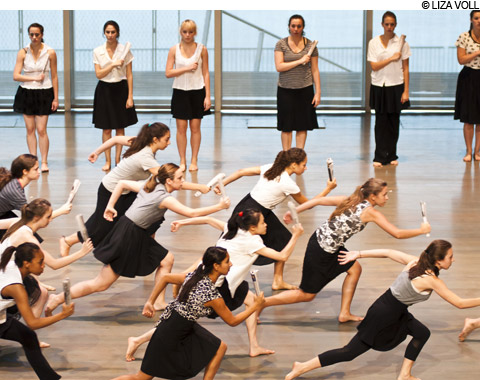
MANUFACTURING CONSENT One of four choreographers featured at the ICA, Edisa Weeks
transformed a Noam Chomsky theory into a dance piece. |
Summer Stages Dance wrapped its 14th season Saturday afternoon at the Institute of Contemporary Art with a presentation by four choreographers who've been working with the students at Concord Academy through July. Directors Amy Spencer and Richard Colton have consistently encouraged the development of creative talent, and this year Summer Stages commissioned a new work from New York choreographer Edisa Weeks. In addition, three choreographic fellows — Kelley Donovan, Adele Myers, and Tennille Lambert — were mentored by Colton, Daniel McCusker, and David Parker.Kelley Donovan concentrated on a formal exposition of lush, variegated movement. In a World began with a female soloist in a circle of light, moving through a vocabulary of stretches and angles, spirals and falls, with subtle gradations of speed and attack. Later, she and nine other dancers expanded the material into a series of group designs, duets, and solos.
Composer John Slepian accompanied the dance with a computer score that exported his percussive tones onto three screens. Every twang or clang resonated behind the dancers on a grid of colored squares, circles, or lines.
The other pieces on Saturday's program were marked by the anti-elitist notions of the '60s — anyone can be a dancer and anything is dance if you want to see it that way. The counterculture broadened the modern dance playing field to include diverse racial and physical types, many levels of technical proficiency, and a range of contemporary themes, and dancing itself went into disfavor for two decades. Technical skills are back, but they weren't much in evidence; perhaps the time was too short for crafting that resource into theatrical coherence.
All four pieces were created in collaboration with the dancers and they all featured built-in showcase moments for the individual performers. In This Dance Is What You See, Adele Myers orchestrated goofy moves and half-serious audience confrontations for 11 dancers. Echoes of minimalism surrounded both this work and Tennille Lambert's in-progress theater piece, Lucky. Holding the audience's interest while standing still takes another kind of talent.
Lucky also relied on strategies from absurdist theater and happenings, confident that two benches, eight women, one man, and a few dozen transparent balloons can be funny, tragic, and profound. The characters either ignored the balloons or tried to collect them. They regarded each other blankly. They considered whether or not to sit on the benches. At every turn, the audience could make up its own explanation.
Edisa Weeks attempted a bigger statement in Manufacturing Consent. Using a theory by Noam Chomsky that explains propaganda as a way of keeping 80 percent of the public from questioning the government, the cast of 34 began with marching formations and phrases of stamping that implied either anger or conformity. They were dressed in black-and-white outfits and carried folded or rolled-up newspapers.
They donned overcoats and stood in a compact crowd, reading out loud from the newspapers. Several of them broke out of the group to run in big circles with their hands in their pockets, falling deliberately, then getting up and running again. Suddenly one of the readers screamed, setting off a mass tantrum. As they rolled on the floor and ripped up their newspapers, they acted out the silent screams we've all been exchanging during the past weeks over the gridlock in Washington.